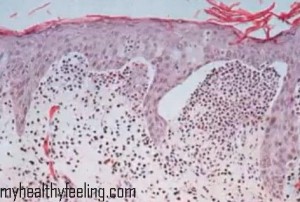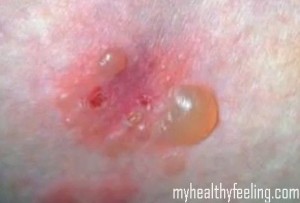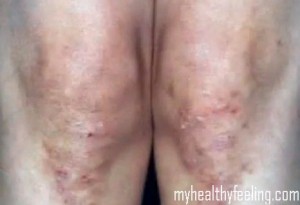What is dermatitis herpetiformis? This is a disorder consisting of a rash that is extremely itchy and made of blisters and bumps. This rash is chronic – continuing over a long period of time. It normally develops in young adults and is most common in men as well as individuals originally from areas of northern Europe.
This disorder occurs in association with an asymptomatic gluten-sensitive disease of the intestine similar to that in celiac disease.
Dermatitis Herpetiformis Pictures
Symptoms of dermatitis herpetiformis
The symptoms of this disorder include:
• Blistering that is small
• Separate bumps
• Itchy, smooth lesions
• Resembles hives
• Appears on the head, knees, elbows, buttock and lower back
• Often blisters and lesions develop on face and neck
• Extremely itchy
• Intense burning or stinging
In rare instances the lesions will occur in the mouth. The severity of this rash may vary, continues for an indefinite period and is a condition that lasts a lifetime. But in a small number of individuals the disorder will remit for long periods of time.
These lesions appear first as discolorations and then consist of the small bumps and blisters. These lesions often occur in groups much as the lesions of Herpes and this is where the term herpetiformis comes from, meaning “like Herpes”.
Due to the intense itching, these lesions are scratched often and these areas that are scratched will develop crusts and then usually heal with changes in color. Most individuals with this disorder can normally predict the location of any new lesion 8 to 12 hours before the actual development because of the symptoms of localized itching and burning. The blisters develop in crops, with all stages seen at any one time. They lose their burning and itching sensations in 7 to 10 days, are rarely inflamed and do not contain any pus.
Causes of Dermatitis Herpetiformis
This disorder is idiopathic meaning “without known cause”, but there are immunologic abnormalities that have been identified. In the lesions there is the presence of IgA – immunoglobulin and its components that leads to the belief that this is an immunoregulatory disturbance. Iodide as well as other halides might cause a flare. It is believed to be a genetically-based sensitivity of gluten.
Onset can be at almost any age but normally occurs in middle adulthood. A slow onset during adulthood is most normal, but appearance in childhood can also occur. Men are more affected than women and it appears to have the utmost occurrence in Scandinavia.
Dermatitis Herpetiformis Treatment
As with celiac disease, the best and only known, side-affect free, treatment for dermatitis herpetiformis (DH) is a life-long adherence to the gluten-free diet. A gluten-free diet is extremely restricting and compliance is quite difficult. Foods that contain gluten include oats, wheat, barley and rye. The main difficulty in the diet comes from gluten being accidentally eaten from time to time. Many individuals report large difficulty in eating away from home and in deciding whether a food is gluten-free.
Treatment that is standard often involves the use of Dapsone to treat the rash. This causes symptomatic relief in one or two days. That urgent need to scratch usually leaves in 1 to 3 days. No one knows exactly how or why Dapsone works. It is an antibiotic that was originally used for leprosy but seems to have a strong antihistamine effect.
Dapsone can be linked with severe blood disturbances so it must be monitored closely. But, strict long-term avoidance of dietary gluten has been shown to reduce dosage of Dapsone needed to control the disease and might even eliminate the need for this medication. Additionally, a gluten-free diet might reduce the risk of gastrointestinal lymphoma.



